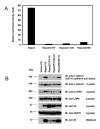Loss-of-function point mutations and two-furin domain derivatives provide insights about R-spondin2 structure and function
- PMID: 19385064
- PMCID: PMC2813491
- DOI: 10.1016/j.cellsig.2009.02.001
Loss-of-function point mutations and two-furin domain derivatives provide insights about R-spondin2 structure and function
Abstract
R-spondins (Rspos) potentiate Wnt/beta-catenin signaling, an important pathway in embryonic development that is constitutively active in many cancers. To analyze Rspo structure and function, we expressed full-length wild-type Rspo2 and Rspo2 point mutants corresponding to Rspo4 variants that have been linked to developmental defects. The Rspo2 mutants had markedly reduced potency relative to the wild-type protein,demonstrating for the first time specific amino acid residues in Rspos that are critical for beta-catenin signaling. The diminished activity of Rspo2/C78Y and Rspo2/C113R was attributable to a defect in their secretion, while Rspo2/Q70R exhibited a decrease in its intrinsic activity. Cysteine assignments in a Rspo2 derivative containing only the two furin-like domains (Rspo2-2F) provided the first information about the disulfide bonding pattern of this motif, which was characterized by multiple short loops and unpaired cysteine residues, and established that the loss-of-function cysteine mutants disrupted disulfide bond formation. Moreover, Rspo2-2F demonstrated potent activity and synergized strongly with Wnt-3a in a beta-catenin reporter assay. In contrast, an Rspo2-2F derivative containing the Q70R substitution showed significantly reduced activity, although it still synergized with Wnt-3a in the reporter assay. Rspo2-2F derivatives elicited an unusually sustained phosphorylation (20 h) of the Wnt co-receptor, low density lipoprotein receptor-related protein 6 (LRP6), as well as an increase in cell surface LRP6. Co-immunoprecipitation experiments involving LRP6 and Kremens suggested that these associations contribute to Rspo2 activity, although the lack of major differences between wild-type and Q70R derivatives implied that additional interactions may be important.
Figures






References
-
- Kim KA, Zhao J, Andarmani S, Kakitani M, Oshima T, Binnerts ME, Abo A, Tomizuka K, Funk WD. Cell Cycle. 2006;5:23. - PubMed
-
- Nam JS, Turcotte TJ, Yoon JK. Gene Expr Patterns. 2007;7:306. - PubMed
-
- Chen JZ, Wang S, Tang R, Yang QS, Zhao E, Chao Y, Ying K, Xie Y, Mao YM. Mol Biol Rep. 2002;29:287. - PubMed
-
- Aoki M, Kiyonari H, Nakamura H, Okamoto H. Dev Growth Differ. 2008;50:85. - PubMed
Publication types
MeSH terms
Substances
Grants and funding
LinkOut - more resources
Full Text Sources
Other Literature Sources

